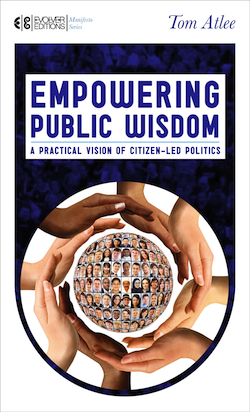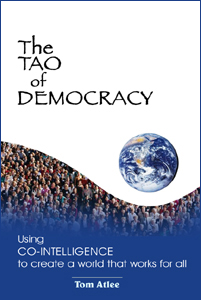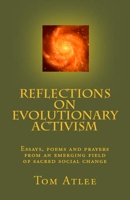 |
Read
Empowering
Public Wisdom -
A Practical Vision of Citizen-Led Politics
Tom Atlee shows us how we can harness our collective wisdom to
discern the way forward in these complex and challenging times.
Inspiring and highly recommended! — William Ury, co-author, GETTING
TO YES and author, THE THIRD SIDE
This book suggests new forms that can embed a wise public voice
in real-world democratic governance a wise and important development for
the democracy movement. — Hawaii State Senator Les Ihara,
Jr., Senate Majority Policy Leader
In this book you will find how diverse citizens can generate a
coherent, shared “voice of the people,” infusing the
political process with wise common sense by learning about, reflecting
on, and discussing what needs to be considered to produce long-term,
inclusive benefits. Doing this together moves us beyond partisanship
to a place of collective responsibility for our shared destiny.
To buy Empowering Public wisdom, 280 pages for $14.95,
click here. To learn more about it, click
here. |
 |
Read
The
Tao of Democracy
Using
Co-Intelligence to Create a World that Works for All
by Tom Atlee
Here-and-now practices showing what's possible in our immediate
future. An important gift for our small, challenged planet! --
Frances Moore Lappé, author of Diet for a Small Planet,
co-author of Hope's Edge
About the most important thing that's happening at the beginning
of the twenty-first century. -- Paul H. Ray, Ph.D, co-author
of The Cultural Creatives
FIVE STARS: A basic book for humanity. -- Robert D.
Steele, Top 100 Reviewer at Amazon.com
Much of the key material on this website -- and more -- is contained
in these 334 pages. To find out more about The Tao of Democracy,
click here. To order it now, click
here. |
 |
Read
Reflections
on Evolutionary Activism
Essays,
Poems and Prayers from an Emerging Field of Sacred Social Change
Tom Atlee offers a fresh, and penetrating perspective —
connecting our understanding of evolution, consciousness, and
activism into a new and compelling synthesis for making a difference
in today's challenged world. —Juanita Brown and David Isaacs,
The World Café
An inspiring manifesto, a handbook, a gift of love and truth
like no other. —Robert Steele, #1 Amazon non-fiction reviewer
Evolution, the most ancient, complex and self-organized of all
change processes, has been going on for 13.7 billion years. We are
now part of that process becoming conscious. Inspired by the Great
Story of evolution and our role in it, and guided by our increasing
understanding of evolutionary dynamics, we can co-create wiser social
systems, cultures, consciousness, and technologies. Much of the
material on this site is part of this co-creative adventure.
To buy Reflections on Evolutionary Activism, 360 pages
for $15,
click here. To download a free PDF of the complete book, click
here. |
Bibliography
of other Co-Intelligence-Related Literature
(not available from the Co-Intelligence Institute)
Methods to nurture collective intelligence
Holism, the new sciences and cultural transformation
Democracy and the new activism
New economics
Community
Approaches to multi-modal intelligence and personality
diversity
METHODS TO NURTURE COLLECTIVE INTELLIGENCE
The Change Handbook: Group Methods for Shaping
the Future, edited by Peggy Holman and Tom Devane (Berrett-Koehler,
1999). Describes 18 different approaches, including dialogue,
future search, open space, appreciative inquiry and participative
design, in doable detail -- with thoughts on the future and a
unique matrix chart comparing all the methods described.
The Fifth Discipline: The Art and Practice of
the Learning Organization by Peter Senge (Doubleday Currency,
1990). This book introduced the world to the idea of an organization
that can learn. It was followed by the The Fifth Discipline
Fieldbook, by Senge, et. al. (Doubleday Currency,
1994), jam-packed with strategies, tools and exercises to help
us build such organizations.
Future Search, by Marvin Weisbord and Sandra Janoff
(Berrett-Koehler, 1995). A how-to book for finding common ground
and co-creating the future of organizations and communities -
www.futuresearch.net.
Nonviolent Communication: A Language of Compassion,
by Marshall B. Rosenberg (PuddleDancer Press, 1999) - Good for
interpersonal communication and thinking about human needs. http://www.cnvc.org
Open Space Technology, by Harrison Owen
(Berrett-Koehler, 1997). The how-to manual for one of the simplest,
most powerful self-organized collective processes we have. http://www.tmn.com/openspace
Facilitators Guide to Participatory Decision-Making, by Sam Kaner, et
al. (New Society, 1996). A detailed guide to facilitated consensus
process, organized so pieces can be copied and used by the group.
Dialogue: Rediscovering the Transforming Power
of Conversation, by Linda Ellinor and Glenna Gerard (J. Wiley
and Sons, 1998).
The Joy of Conversation, by Jaida N'ha Sandra
(Utne, 1997). The Utne Reader-sponsored guide to co-creative salons
of all types. Excellent writeups on study circles, listening circles,
etc. - www.utne.com
Study Circles, by Len Oliver (Seven
Locks, 1987). The history and practice of small-group, democratic,
adult education and social learning. https://www.everyday-democracy.org/ (formerly the Study Circles Resource Center)
Calling the Circle: The First and Future Culture, by Christina Baldwin (Bantam 1998). A spiritual
approach to talking/listening circles. http://www.peerspirit.com
.
The Leader as Martial Artist, by Arnold Mindell
(HarperSF, 1992). The Aikido of conflict resolution, relationship
and change.
Confessions of Empowering Organizations, by
Redburn, Ray, et al. (Association for Quality and Participation,
1991). 92 case studies of partnership and empowerment, self-managed
work crews, self-directed reorganizations -- with names and phone
numbers.
Getting to Yes, by Roger Fisher and Willima
Ury (Penguin, 1981). The classic introduction to principled negotiation.
(See review of Roger Fisher's books
by Rowan Smith and William Ury's GETTING
TO PEACE.)
go to top of bibliography->
HOLISM, THE NEW SCIENCES AND CULTURAL TRANSFORMATION
Complexity, by M. Waldrop (Simon
& Schuster, 1992). This book opened my eyes to the way nature
generates totally new phenomena through the co-evolution of complex
synergies.
Leadership and the New Science, by Margaret
Wheatley (Berrett-Koelher, 1999). How to relate to organizations
as natural systems. http://www.berkana.org
Seven Life Lessons of Chaos: Timeless Wisdom from the Science of Change, by John Briggs and David Peat (HarperCollins,
1999) - A brief layman's introduction to chaos theory and how
it applies to life.
The Web of Life: A New Scientific Understanding
of Living Systems, by Fritjof Capra (Doubleday, 1996). Our
favorite all-around introduction to the new sciences.
Seeing Nature: Deliberate encounters with the
visible world, by Paul Krapfel (Chelsea Green, 1999) - Engaging
examples of nature dancing entropy into life, and how we humans
can join that dance. http://www.krafel.net
The Aquarian Conspiracy, by Marilyn Ferguson
(Tarcher,1980). The book on the holistic "new paradigm"
revolution which laid the groundwork for co-intelligence.
Necessary Wisdom, by Charles Johnston (ICD
Press, POB 85631, Seattle, WA 98145; 1991). The dance of opposites
into creative co-evolution; building living bridges between us,
where we come alive together.
Transforming Human Culture, by Jay Earley
(SUNY, 1997). Tracking the evolution of integral culture from
prehistory into the 21st Century. http://www.earley.org
Reworking Success, by Robert Theobald (New
Society, 1997). An accessible re-examination of how to make communities
and societies work better in the 21st Century. http://www.resilientcommunities.org
New World, New Mind, by Robert Ornstein and Paul Ehrlich (Touchstone,
1989). One of the biggest obstacles to social change is that our
human nervous system, wired for life in nature, leaves us unable
to directly perceive and respond to the many "invisible"
threats generated by civilization.
go to top of bibliography->
DEMOCRACY AND THE NEW ACTIVISM
The New State by Mary Parker Follett. This 1918 classic explains the first vision
of holistic democracy and has a greater density of quotable material
on this subject than anything we know of. Follett coined the term
"power-with." It is available in full online.
Society's Breakthrough: Releasing Essential Wisdom and Virtue
in All the People by Jim Rough (1stBooks, 2002). The creator
of Dynamic Facilitation and the Wisdom Council weaves them into
an innovative political vision that could make a real difference.
http://www.societysbreakthrough.com
Heart Politics, by Fran Peavey (New Society, 1986).
One of the most creative inquiries into what it means to live
a life trying to change things for the better, sensitive to the
interconnectedness, mystery, beauty and quirkiness of life.
The Quickening of America, by Frances Moore
Lappé and Paul Du Bois (Jossey-Bass, 1994). Powerful examples
and new theory about how Americans are "doing democracy."
http://www.livingdemocracy.org/
Democracy and Technology, by Richard Sclove
(Guilford, 1995). Shows how technologies support and undermine
democracy, and asks: "What role should democracy have in
the development of technology?" http://www.loka.org/
The Double Helix: Technology and Democracy in the American
Future by E. Wenk (Ablex,1999). Describes the threats
to democracy from technological innovation, focusing on those
that require a political rather than technological solution.
Resource Manual for a Living Revolution, by Virginia
Coover, Ellen Deacon, Charles Esser, and Christopher Moore (New
Society Press, 1978) - Vision, analysis and practices from the
Movement for a New Society who brought consensus and affinity
groups broadly into activist movements.
A House Divided: Six Belief Systems Struggling
for America's Soul, by Mark Gerzon (Tarcher/Putnam 1996).
The divisions in America and how a new brand of patriots are trying
to bridge those chasms.
go to top of bibliography->
NEW ECONOMICS
The Post-Corporate World: Life After Capitalism, by
David C. Korten (Berrett-Koehler, 1999). A vision to move beyond
corporatism to "eliminate the economic pathology that plagues
us and create truly democratic, market-based, life-centered societies."
The Ecology of Commerce, by Paul Hawken (HarperBusiness,
1993). How an economy would work that fully collaborated with
nature.
Natural Capitalism: Creating the Next Industrial
Revolution, by Paul Hawken, L. Hunter Lovins, Amory Lovins
(Back Bay Books, Oct 2000) - More about a nature-based economy,
including powerful technical developments. http://www.naturalcapitalism.org
Who's
Counting: Marilyn Waring on Sex, Lies, and Global Economics
- A very moving film about the
measurables and immeasurables in our lives, and how economic measurements
and policies affect them.
Calvert-Henderson
Quality of Life Indicators, edited by Hazel Henderson,
Jon Lickerman, and Patrice Flynn. Here are detailed, sensible
ways to measure a dozen diverse aspects of our national well-being,
so we as citizens can tell if things are getting better or worse,
and take action.
go to top of bibliography->
COMMUNITY
Creating Community Anywhere, by Carolyn Shaffer
and Kristin Anundsen (Tarcher/Perigree, 1993). "The most
comprehensive book I know of about the community movement."
-- M. Scott Peck. Building community with friends, family, support
groups, neighborhoods, co-workers, cyber-companions, shared households
and visionary communities. Excellent guidance on conflict, decision-making,
celebrations, communication and dealing with community evolution
and "shadow side."
Building Communities from the Inside Out: A Path
Toward Finding and Mobilizing a Community's Assets, by John
P. Kretzmann and John L. McKnight (Center for Urban Affairs and
Policy Research, 1993; $15 from ACTA Publications [800] 397-2282)
http://www.nwu.edu/IPR/abcd.html
The Spirit of Community: The Reinvention of American Society, by Amitai Etzioni (Touchstone/Simon & Schuster,
1993). The kick-off of the communitarian movement.
Habits of the Heart: Individualism and Commitment
in American Life, by Robert N. Bellah, et al (U of California,
1985). A breakthrough classic on the nature of American community.
A Different Drum by N. Scott Peck. Tells us what
needs to happen for us to feel like we're in community.
The Power in our Hands: Neighborhood-Based World
Shaking, by Tony Gibson (Jon Carpenter, UK,1996). How-tos
and stories for those who want to make a creative difference in
their communities.
Going Local: Creating Self-Reliant Communities
in a Global Age, by Michael H. Shuman (The Free Press, 1998).
The title says it.
Self-Reliant Cities, by David Morris (Sierra
Club Books,1982). The classic visionary text on the relationships
of American cities to energy. This and many other books on that
topic can be found at http://www.ilsr.org/pubs/pubbroch.html
go to top of bibliography->
APPROACHES TO MULTI-MODAL INTELLIGENCE & PERSONALITY DIVERSITY
Who Do You Think You Are? by Keith Harary and
Eileen Donahue. (HarperSF, 1994). How to use The Berkeley Personality
Profile, which explores human differences without "typing"
people.
The Three Faces of Mind by Elaine de Beauport
(Quest, 1996). An integrated theory of multi-modal intelligence
based on the functions of the three parts of the human brain.
Frames of Mind by Howard Gardner (Basic Books,
1993). The first fully-researched theory of multiple intelligences
that opened the door to expanded views of intelligence.
Emotional Intelligence by Daniel Goleman (Bantam,
1995). How we deal with our (and others') emotions can be a greater
indicator of success than our IQ. A direct and successful challenge
to the "cult of IQ."
The HeartMath Solution by Doc Childre and Howard
Martin (HarperSF, 1999). Scientific evidence of the intuitive
problem-solving capacity of the heart, and how to access it. http://www.heartmath.org
Seven Kinds of Smart: Identifying and Developing Your Many Intelligences by Thomas Armstrong (Plume, 1993). An accessible,
useful popularization of Howard Gardner's ideas.
Personality Types: Using the Enneagram for Self-Discovery
by Don Richard Riso (Houghton Mifflin, 1987). An introduction
to one of the most popular personality typing systems.
LifeTypes by Sandra Hirsch and Jean Kummerow (Warner,
1989). A popularization of the widely-used Myers-Briggs system
of typing based on Carl Jung's analysis of personality.
Home || What's New || Search || Who We Are || Co-Intelligence || Our Work || Projects || Contact || Don't Miss || Articles || Topics || Books || Links || Subscribe || Take Action || Donate || Legal Notices
|




